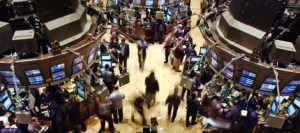
April 4, 2018 | Daily JAM, Morning Briefing, Short Term |
The Standard & Poor’s 500 stock index finished up 1.16% today, closing at 2644.69, as traders and investors decided that the tariff measures targeting China that the Trump administration announced last night and the retaliatory measures announce by China today would never be put into effect. Instead the two countries would talk away their trade differences, or the Trump administration would back down, or something. You’ll note that I’m skeptical.

April 2, 2018 | Daily JAM, Mid Term, Morning Briefing |
It’s always hard to attribute a market move to one particular news event, but today the odds are good that this morning’s plunge in stock prices is in reaction to China’s decision to impose tariffs on 128 U.S. products in response to the Trump administration’s new tariffs on imported steel and aluminum. The big target in China’s move is U.S. pork exports–the United States exported $1.1 billion in pork to China in 2017.

March 28, 2018 | Daily JAM |
If you’re having a hard time figuring out what parts of the Trump administration’s tariff plans are serious (and thus might provoke a global trade war) and what parts are bluster (designed as outliers in an ongoing negotiation), you’re not alone. The financial markets are bouncing between panic–at the potential end of global growth–and relief–because the final positions won’t be all that bad. And unfortunately, the whiplash is not about to get any better.

March 23, 2018 | Daily JAM, Morning Briefing, Short Term, Volatility |
U.S. stocks started the day in the green with the Standard & Poor’s 500 stock index up 0.44% was of 9:33 a.m. New York time. The index was still in the green as of 11 a.m. (up 0.38%) but then came the retreat. As of 11:30 a.m. the S&P 500 was off 0.37%. The Dow Jones Industrial Average was lower by 0.25% and the NASDAQ Composite had declined 0.64%. The drop in the indexes came even as oil and energy stocks rallied

March 22, 2018 | Daily JAM, Uncategorized, You Might Have Missed |
This isn’t going to sound very technical or sophisticated but to me the day feels like one where lots of traders and investors decided that they just couldn’t see any near term upside and in the absence of that upside they decided to sell. This pessimism strikes me as a delayed reaction to yesterday’s Fed meeting and a new dot plot that showed increased sentiment at the Federal Reserve for at least two more and possibly three more interest rate increases in 2018–and more rate increases to come in 2019 and 2020. In this context the President’s China tariff proposal isn’t the killer but rather just one more negative element.

March 22, 2018 | Daily JAM, Morning Briefing, Short Term |
The only thing that is (relatively) certain is that President Trump will announce $50 billion in tariff and other trade restrictions aimed at China. That announcement is scheduled for 12:30 p.m. today in Washington. There’s plenty of speculation today about the nature and extent of China’s response.

March 19, 2018 | Daily JAM, Short Term |
The Washington Post reports tonight that President Donald Trump is preparing to impose a package of $60 billion in annual tariffs against Chinese products. The tariff package, which Trump plans to unveil by Friday, was confirmed to the Washington Post by four senior administration officials.

March 14, 2018 | Daily JAM, Mid Term, Volatility, You Might Have Missed |
Today the White House announced that President Donald Trump has picked Larry Kudlow to replace Gary Cohn as director of the White House National Economic Council. Kudlow worked as an economic advisor to President Reagan where he was a dedicated believer in supply-side economic policies, and he is known as an advocate of expanding global trade. I believe Kudlow’s appointment to the job of the administration’s top economic adviser just about assures that the President will announce a big package of tariffs (and maybe other measures) aimed at China within the next week or two. Such a package would certainly increase the chances of a trade war between the United States and China.

March 14, 2018 | Daily JAM, Notes You Need |
In my daily trawling through the market I come upon lots of tidbits of knowledge that I think are important to investors but that don’t justify a full post. I’ve decided to start compiling these notes here each day in a kind of running mini blog that I’m calling Notes You Need. This post from today is a representative item: “10:20 a.m.: Not a single 10-year note traded in Japanese markets yesterday. The Bank of Japan now holds 40% of all Japanese government debt. Add in such buy-and-hold investors as pension funds and life insurance companies and there’s just not much Japanese Government paper to buy or sell–especially for the 10-year benchmark. My favorite comment was this from Barclays Securities Japan rates strategist Naoya Oshikubo to Bloomberg: “The JGB market was generally thin.” This would seem to suggest that the Japanese government’s policy of buying bonds to reduce interest rates and weaken the yen has reached an endpoint–in the government bond market anyway.”
March 13, 2018 | Daily JAM, Short Term |
I’m actually surprised that U.S. stocks have held up as well today as they have. The Standard & Poor’s 500 fell 0.64% at the close and the Dow Jones Industrial Average was off 0.68%. The NASDAQ, which had been leading markets higher recently, fell harder but still showed only a 1.02% drop at the close. Not bad for a day when President Donald Trump announced the departure of Secretary of State Rex Tillerson. And when a Politico headline said that new steep tariffs and investment restrictions on China could be coming as soon as next week.

March 10, 2018 | Daily JAM, Friday Trick or Trend |
So which countries will get an exemption from the Trump administration’s 25% tariff on imported steel and 10% on imported aluminum? If the administration passes out enough exemptions, then what remains will be a tariff targeted at China–and maybe at South Korea.

March 8, 2018 | Daily JAM |
At a ceremony in the White House President Donald Trump signed an executive order authorizing a 25% tariff on imported steel and 10% on imported aluminum. The tariffs will go into effect in 15 days. Mexico and Canada are exempt from the tariffs for an indefinite time.










